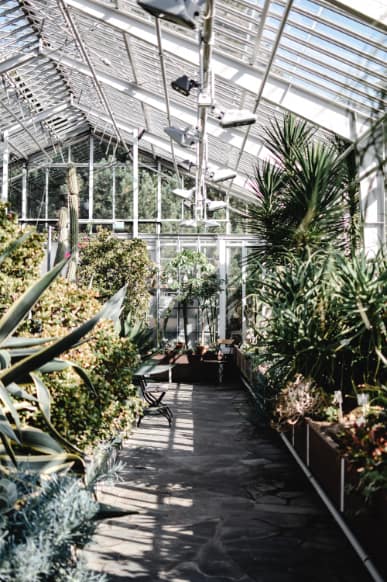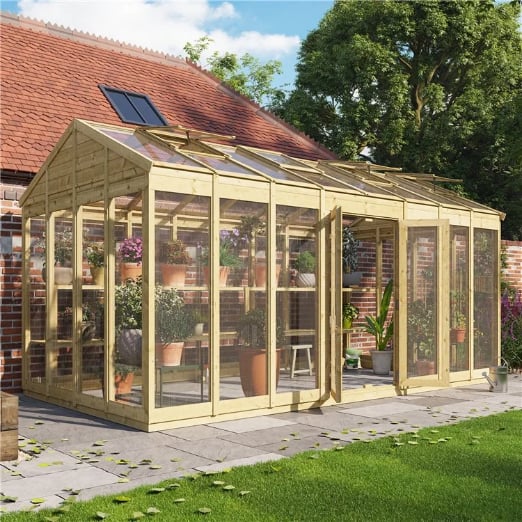Jump to:
Building a budget greenhouse might be the solution if 1.) you’re starting out on your gardening journey, 2.) you can’t find a unit that fits your space, or 3.) you’re keen to take the DIY route but don’t know where to begin.
If any of these sound like you, here are things you must consider before proceeding with the project.
Start with the Basics of a Greenhouse

For a greenhouse to work in favour of plants, it needs to create a microclimate. This protects crops from external conditions, helping them grow and thrive. The components involved in achieving this are:
- Cladding material – This covers the greenhouse and controls light, heat, and humidity inside. It goes over the frame and gives the setup its shape.
- Shape – The greenhouse structure affects airflow, temperature regulations, and light distribution. We’ll go into this more later.
- Orientation –This refers to the direction the greenhouse faces. It influences how much sunlight it gets throughout the day, which is crucial for plant growth. Maximum light exposure is crucial.
Cladding Materials That Work Well with Greenhouses

You have two options: plastic and glass.
Plastic is lightweight, durable, and affordable. It comes in different types, with polycarbonate being the popular type. It offers good insulation, keeping the greenhouse warm in winter and cool in summer. Good quality and UV-treated polycarbonate can also handle rough weather without cracking.
Glass leans towards a more traditional option. It allows for excellent light transmission, meaning plants get plenty of sunlight. But it does come with higher upfront costs and maintenance since it’s prone to breaking. Tempered glass is worth considering for a stronger and safer alternative.
Plastic is probably the most cost-effective option for your budget greenhouse purchase.
We have gone into further detail on this in our guide: Glass v Polycarbonate Greenhouses.
Cladding vs frame
The cladding material on a greenhouse is the glazing, while the frame is the structure that supports it. The frame is often made with wood and metal. Greenhouses are often categorised by the type of frame they’re built with.
A greenhouse with a timber frame is a wooden greenhouse, no matter the cladding material. If it has a metal frame, it’s a metal greenhouse.
Based on current market conditions, a wooden greenhouse is often cheaper than a metal one. However this does come with added (albeit low) maintenance costs as the wood needs to be kept treated.
Note: You also might come across the term ‘polycarbonate greenhouse’. This usually means it has polycarbonate cladding with either wood or metal frame.
Different Types of Greenhouse Shapes
The common structural designs of greenhouses are gable, hoop, and lean-to.
A gable greenhouse, also known as an apex greenhouse looks like a classic house with a pitched roof. It has a triangular section formed by the apex roof at the ends of the structure. A good example is the BillyOh Switch, which has a design that lets plenty of light in and allows good airflow.
A hoop or quonset greenhouse has a rounded, tunnel-like shape. It’s easy to build and budget-friendly, but sidewalls can limit space. The curved sides reduce how much usable space you get along the edges. And the way they slope inwards makes it tricky to place tall plants, shelves, or equipment.
A lean-to, as the name suggests, leans against an existing wall, like a house or a shed. It’s more compact, but you can make it bigger as long as the space allows.
What shape is best for a budget greenhouse?
A hoop greenhouse is simple and cheap to build. For the frame, go for galvanised steel or aluminium. Polycarbonate is durable, but plastic sheeting is cheaper for the cover.
A gable design may cost more to build, but it’s worthwhile if you want a sturdier and permanent setup. Go for a lean-to if you have a small garden, though it’s limited in size.
The Best Spot for Your Greenhouse
We’re adding this because the shape can affect where you should place it. For instance, a lean-to greenhouse wouldn’t be best if the wall it’s leaning against doesn’t get much sunlight. And when you’re looking for a budget greenhouse, you want to ensure you get the best growing results for your money.
Thus, look for a spot that receives maximum sun exposure. From there, choose a structural design that fits. Don’t be afraid to adjust it to make it work for your space.
Our guide on the best position for a greenhouse has more details.
Round-up
The basics are a good starting point as they help you decide what type of greenhouse will fit your space and needs. We hope this quick guide helps with that. For further advice, check out our greenhouse buying guide.
For design inspiration, feel free to check our greenhouses for sale. Have questions? Our team is here to help! Give us a call at 01909 768840.
Up next on your reading list: How to Set Up Your Greenhouse for Success





